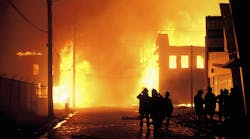A technical review of the 1999 Worcester, Mass., fire that claimed six firefighters is being released by the Department of Homeland Security's Federal Emergency Management Agency (FEMA) today.WASHINGTON, D.C. - A technical review of the 1999 Worcester, Mass., fire that claimed six firefighters is being released by the Department of Homeland Security's Federal Emergency Management Agency (FEMA) today. According to the review, abandoned buildings are a serious threat to firefighters and fire departments must make a concerted effort to use technology to maintain data on buildings in their response districts.
This report offers valuable insights that will help prevent deaths and property loss in the future," said Michael D. Brown, Homeland Security Under Secretary for emergency preparedness and response. "This review for 'lessons learned' is particularly important for the fire service, which can use the information to better safeguard firefighters."
The review, compiled by the U.S. Fire Administration (USFA), also notes that delayed reporting contributed to the warehouse fire's spread and that fire services should initiate rapid intervention teams earlier in a structure fire response and use a strict system of personnel tracking on the scene.
Other lessons learned cited in the report include:
- Fire prevention efforts should target abandoned and even temporarily vacated building to avoid fires;
- Proper permitting and on-going building inspections for construction changes within businesses can help reduce non-compliant interior finishes that contribute to combustion;
- Large buildings such as warehouses and high rises require special search techniques and tools, including additional air tanks;
- Better techniques must be developed to better track the movements of firefighters within a structure;
- Alternative radio channels should be explored as radio channels can be overloaded at multiple alarm fires;
- Thermal imaging cameras, while expensive, are invaluable equipment for all fire departments.
The Worcester fire dealt a serious blow to the nation's fire service," said US Fire Administrator R. David Paulison. "It was one of the largest firefighter death tolls for a single event before the World Trade Center tragedy. It merited our study and resulted in findings relevant to every department in the nation."
USFA develops reports on selected major fires, usually involving multiple deaths or a large loss of property. The objective reviews are intended to uncover significant "lessons learned" or new knowledge about firefighting or to underscore ongoing issues in fire service. USFA, which has no regulatory authority, sends an experienced fire investigator to the community after a major incident only after conferring with local fire authorities.
At the time of the fire, the Worcester Fire Department had 469 uniformed personnel, 15 engine companies and seven ladder companies operating out of 12 stations. The year before the fire, the department responded to more than 20,000 emergency calls and fought 459 structure fires. The six-story warehouse building was in the heart of the town's former warehousing and cold storage district. It had been abandoned for a decade before the fire but was frequented by homeless individuals.
The fatal fire was started when homeless individuals overturned a candle inside the warehouse. It was reported to fire officials by an off-duty police officer who saw smoke coming from the warehouse roof. Eventually going to five alarms, the fire took more than 20 hours to extinguish. It also took more than six days to recover all the bodies of the deceased firefighters.
A copy of the full report can be ordered by going to: http://www.usfa.fema.gov/applications/publications/tr134.shtm.
On March 1, 2003, FEMA became part of the U.S. Department of Homeland Security. FEMA's continuing mission within the new department is to lead the effort to prepare the nation for all hazards and effectively manage federal response and recovery efforts following any national incident. FEMA also initiates proactive mitigation activities, trains first responders, and manages Citizen Corps, the National Flood Insurance Program and the U.S. Fire Administration.





